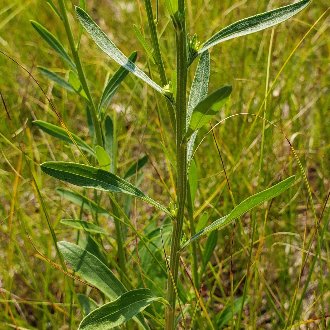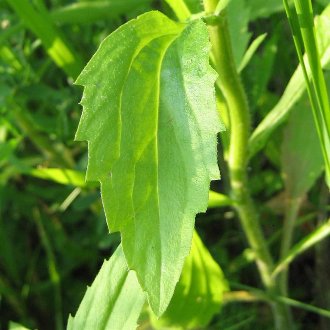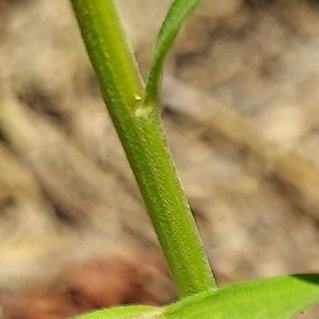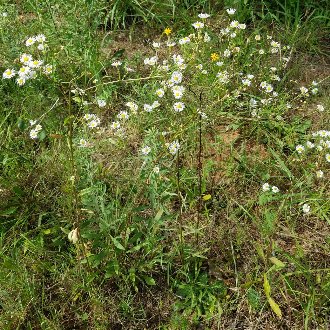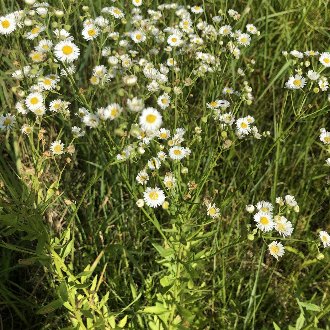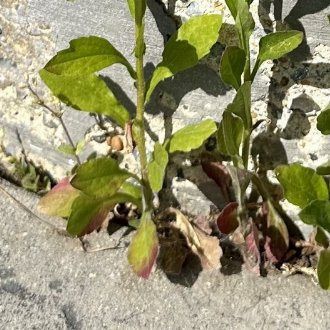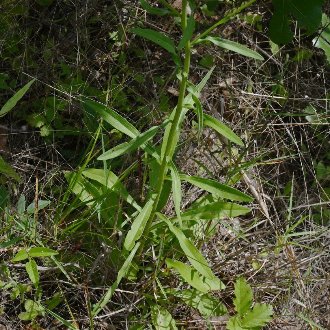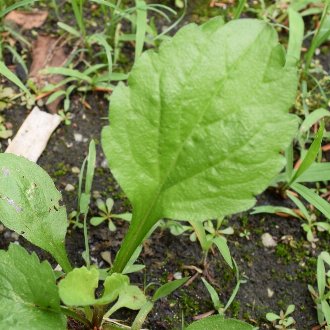Prairie Fleabane vs Annual Fleabane
These closely-related species are visually similar and can occur together in the same habitats, tend to bloom around the same time, and their flowers are nearly indistinguishable. E. annuus favors moister, more disturbed habitats with richer soil, and tolerates more shade, whereas E. strigosus ranges farther west and south, prefers drier, sunnier, slightly less disturbed habitats, and is more tolerant of alkaline soil.
Prairie Fleabane (Erigeron strigosus) | Annual Fleabane (Erigeron annuus) |
A common annual or biennial of sunny sites, native to much of North America, particularly abundant in the Great Plains. | A common weedy annual or biennial native to Eastern North America, and introduced along the West Coast and nearby interior regions. |
Less numerous, smaller leaves. Foliage looks sparse, and lets through a lot of light. Photo © aarongunnar, CC BY 4.0. | More numerous, larger leaves. Foliage usually looks lush, and lets through less light. Photo © Sandy Wolkenberg, CC BY 4.0. |
Leaves average longer and narrower, with most leaves usually <1cm wide. Photo © harrier, CC BY 4.0. | Leaves average shorter and wider. Leaves to about halfway up on the stem are usually >1cm wide, often much more so. Photo © rboles, CC BY 4.0. |
Hairs along the stem, especially from the midpoint upward, are usually pressed upwards along the stem. Some hairs lower down on the stem may be spreading. Stems average less densely hairy. Photo © Athena Philips, CC BY 4.0. | Stems are covered in spreading hairs, especially lower down on the stem. Stems average more densely hairy. Photo © Bill Keim, CC BY 4.0. |
Averages much shorter (30–70 cm) with only slight overlap. Photo © Leila Dasher, CC BY 4.0. | Can grow much taller, typically to 60–150 cm, rarely shorter, usually only on very harsh sites or if resprouted after top-killed. Photo © John Kees, Public Domain. |
Basal leaves are usually still persistent at the time of flowering. Photo © harrier, CC BY 4.0. | Basal leaves are usually (not always) withered by the time of flowering. Photo © Emily Summerbell, CC BY 4.0. |
Size of leaves along the stem gradually reduces from the base of the plant upward, with leaves at the midpoint of the stem considerably smaller than those closer to the base. Photo © Alan Rockefeller, CC BY 4.0. | Size of leaves along the stem remains relatively constant (not much reduced) from the base of the plant to about halfway up the stem. Leaves only become strongly reduced in the top half of the plant. Photo © Charlie Hohn, CC BY 4.0. |
Basal leaves are often narrower, with the leaf blade tapering more gradually to petioles (stemlike portion of the leaf, connecting the leaf blade to the base of the plant) that are not as conspicuously winged. Photo © Gaudaceous Cress, CC BY 4.0. | Basal leaves are often broader; the leaf blade has a more well-defined base, and is connected by a conspicuously winged petiole. Photo © , CC BY-SA 4.0. |
Additional Notes
Some sources report serration pattern along leaf margins as a characteristic for distinguishing these species, but we (and FNA) find this unreliable, noting that both species can have entire (unserrated) leaf margins, as well as varying levels of serration.As with many species, the differences in characteristics used to ID these plants correspond to adaptations to different habitats and lifecycles. The richer, more-disturbed habitats favored by E. annuus tend to have more competition from other plants. This favors plants growing taller to avoid being shaded out. By the time of flowering, their basal leaves are often more shaded, so having them wither results in little loss of photosynthetic capacity. The greater moisture and nutrient availability also leads to the production of more and wider leaves, which also helps with competition and leads to greater shade tolerance. In the absence of competition, however, the lower leaves will often wither as the plant matures, due to drought stress. The ephemeral nature of these disturbed habitats favors an annual lifecycle.
E. strigosus, on the other hand, favors more stable habitats where the open conditions are more a factor of persistent dry, nutrient-poor conditions, such as rocky soils on slopes or upland sites, or moving west, prairies where lower rainfall creates persistent open conditions. In these habitats, there is less competition, but greater drought stress, thus favoring a shorter growth habit and the growing of fewer, narrower leaves. These conditions also favor the conserving of basal leaves through the plant's lifecycle, thus reducing nutrient use, and they also slightly favor perennial growth and persistence through multiple years.
Both of these species are opportunistic, and both can grow as annuals, biennials, or short-lived perennials. Furthermore, both species exhibit high morphological plasticity, meaning that they will look very different in different habitats. These is a degree to which plants of one species will look more like those of the other, if growing in habitats closer to those preferred by the other. For example, in drier, sunnier, nutrient-poor habitats, E. annuus will grow shorter and have fewer, narrower leaves. And on richer sites with more competing vegetation and less sunlight, E. strigosus will grow taller and with broader leaves.
References & External Resources
These short lists show only links helpful for ID. For a complete list of references and resources also covering other aspects of ecology, visit the links section of the full article on each plant, which is the first entry here.



